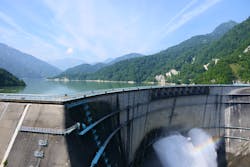Hydroelectric power plants in Japan have been vital to the national energy supply for many years, and today’s demands for low-carbon energy make these resources more valuable than ever. To maximize production, plant executives across the country are taking a critical look at their outdated business systems. Many tasks in these plants are not automated and must be carried out manually. On-site operators and other staff often send status reports by email or verbally over the phone. Production data arrives late or in fragments, making it difficult, and in some cases impossible, to create a coherent picture of what’s happening. Without site-wide trend charts and other analytical tools, management has little knowledge of the real-time operational status of the plants. This leads to inefficient plant operations, high manpower requirements, and increasing costs.
The Tepco Systems Corporation (TepSys) of Tokyo, Japan, recently completed a digital transformation project to upgrade data collection, storage, and visualization for a customer operating a hydroelectric power plant in central Japan. Without disrupting existing equipment or business procedures, TepSys was able to quickly transition the company from manual to automatic data collection and distribution, saving time and manpower, and providing a platform for advanced data analytics.
Although engineers and managers at these plants are typically aware of the inefficiencies, modernizing and digitalizing is difficult. Business systems and control devices are often inseparably tied to the plant machinery, making them very costly to replace. What is required is a way to automate and provide data visualization without disrupting existing systems or equipment. The ideal solution is one that is quick to implement, integrates well with the systems in place, and—as much as possible—free from errors. Mistakes are not an option.
TepSys meets the challenge
Last year TeoSys was asked to solve this kind of problem. One of their customers needed to upgrade their data collection and utilization methods, which at that time relied on members of the control group sending emails and making regular phone calls to the company’s main offices to inform them of the latest status of the power generation system. This had been working reasonably well for a long time, but it was not very efficient.
To meet these requirements, TepSys turned to BellChild Co. Ltd., a system integration company located in Osaka specializing in security, robust infrastructure, and advanced operations capabilities. “After looking over the specifications for this project, we suggested DataHub software from Skkynet as the best solution,” said Mr. Fujiwara, general manager of the iBress Division at BellChild. “DataHub technology offered three key advantages: connectivity, high-speed data storage, and visualization. Being secure by design makes it ideal for use in the energy sector.”
The TepSys team installed DataHub software on their self-hosted TepCube cloud service, and connected most of the control systems and plant equipment to it via Modbus TCP. Other data was logged to CSV files, which were read by the DataHub instance, then aggregated with the other data into a single, universal data set. The team quickly configured InfluxDB, a real-time data historian, to collect the data and provide high-speed access for retrieval. They were able to easily build screens to display this logged data with the DataHub WebView HMI.
“We had a pilot system running in a few days,” said Mr. Hiroki Suga, TepSys project manager. “Other approaches required combining multiple pieces of software and building an HMI, meaning high development costs and longer implementation times. The DataHub solution was the most cost-effective way to combine business automation and on-site visualization of the whole system.”
Success and future prospects
The final turn-key solution was approved and handed over in a few months, and the project was a resounding success. Plant management have streamlined their business procedures and enhanced data analytics. Staff now spend less time travelling to read data meters, and more time planning what systems to access and how to improve their operation. “Our business procedures have changed significantly, and we have been able to make things more efficient,” said the lead plant engineer. “Until now, we would go to the site to check the data as needed, but now we decide what data we need by ourselves, and we link that data to the DataHub. As more of us begin using WebView we expect greater improvements in the future.”
TepSys credited customer and supplier involvement as key to the success of the project. “We spent a lot of time listening to plant engineers and managers, and adjusted project specifications accordingly,” said Mr. Suga. “Using a basic design, we confirmed the necessary DataHub functions and configuration with BellChild in advance, and then proceeded step by step, confirming at each point how to best implement DataHub features.”
BellChild expects to be working closely with TepSys to expand their use of DataHub technology. The need to integrate OT (operations technology) with IT is being felt throughout the Japanese industrial sector. “We are counting on continued support from BellChild as we offer the OT-to-IT model from this project to other customers at power plants, factories, and similar facilities,” said Mr. Kouichi Nishikata, manager of the power control system division at TepSys. “DataHub advantages of rapid implementation, secure design, and built-in HMI, all in a single off-the-shelf package, will ensure they get a top-quality system at a reasonable cost.”


